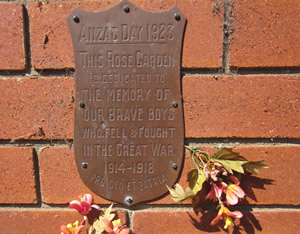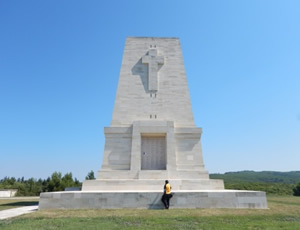Science and technology ES1
Overview

Memorial at North Ryde Public School
Students investigate how memorials within their school are made to suit their purpose. They identify the materials commonly used in the construction of memorials. Students design a memorial to commemorate an event within their school.
Teaching and learning activities

Lone Pine Memorial, Gallipoli, 2014
©Department of Education (Wiley Park GHS)
How are memorials within the school made to suit their purpose?
Question and predict
-
With reference to the students’ everyday lives, ask students what materials last a long time, such as bricks, stone, timber, metal.
-
Show students images of memorials within the school, such as plaques, monuments, memorial fountains, honour boards. View the NSW government’s Register of War Memorials in NSW.
-
Ask students to predict what materials are used to make each.
Investigate
-
Students examine each of the memorials within the school.
-
Discuss the purpose and significance of each memorial.
-
Students touch and identify the materials.
-
Demonstrate the workings of the flagpole.
-
Rubbings could be taken of engraved metal or stone memorials.
-
Discuss the reasons for the chosen materials.
-
Discuss reasons for the location of the memorials.
-
Photograph the memorials.
Process and analyse data and information
-
Group, display and label the photographs of memorials.
-
View photographs of local, state and national ANZAC memorials, including Gallipoli.
-
Discuss similarities and differences between the memorials and the materials used.
Communicate
-
Students label the materials used in memorials in photographs.
-
Students create a labelled sketch of a design for a memorial in the school to commemorate an event.
-
As an extension, students create a model of a flagpole and explain how it works.
Learning concepts
These additional questions can be used for discussion or further investigations.
Caring
Why are memorials erected?
How can memorials within the school and local community be cared for?
Community
What materials are used for the construction of memorials in the school, local and broader community?
What locations in the community are chosen for memorials?
Commemoration
What memorials are in our school? What is their purpose?
How is scientific knowledge used in creating enduring memorials for commemoration?
Syllabus links
STe-4WS A student explores their immediate surroundings by questioning, observing using their senses and communicating to share their observations and ideas.
STe-10ME A student recognises how familiar products, places and spaces are made to suit their purpose.
Working scientifically
Students question and predict by:
-
responding to questions about familiar objects and events they are curious about in the natural and made environments (ACSIS014)
-
making predictions resulting from their questions
Students plan and conduct investigations by:
-
exploring and making observations by using their senses to gather information about objects and events in their immediate surroundings (ACSIS011, ACSHE013)
Students process and analyse data and information by:
-
engaging in discussions about observations and using drawings to represent ideas (ACSIS233)
Students communicate by:
-
using a range of methods to share observations and ideas, such as drawing, informal and guided discussion, role-play, contributing to joint construction of short texts and/or using digital technologies (ACSIS012)
Made environment
Products, places and spaces in the immediate environment are made to suit their purpose.
-
explore a range of existing products, places and spaces, and discuss their likes and dislikes
-
identify a variety of materials that are used in a range of existing familiar products, places and spaces
-
communicate their ideas about how familiar products, places and spaces work and have features that help them to be useful, such as shoulder straps, zippers and compartments in a school bag
-
sketch or model ideas for a product, place or space and recount how their ideas suit their purpose